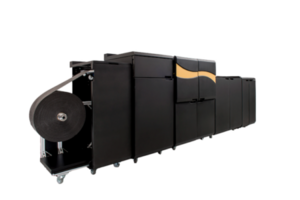Sheet Lamination: Difference between revisions
Jump to navigation
Jump to search
No edit summary |
|||
| (16 intermediate revisions by the same user not shown) | |||
| Line 1: | Line 1: | ||
== Process description == | == Process description == | ||
[[File:Sheet lamination part.png|right|frameless|602x602px]] | |||
Sheet Lamination is one of the most flexible Am methods when it comes to materials, as it can accommodate any material that can be formed into a sheet. In Sheet Lamination, each layer of the print is cut out of a roll of sheet stock and stacked and bound using different material dependent processes (most commonly an adhesive). | |||
== | == Strengths & Weaknesses == | ||
* ''' | === Strengths === | ||
* ''' | * '''Speed:''' Sheet lamination need only cut out the perimeter of the each layer, instead of filling in the whole area. | ||
* ''' | * '''Large material selection''': Most materials are sheet stock that is compatible with the bonding process, so it can use a larger variety of materials than other processes. | ||
* '''Micarta printing''': Micarta is a layered material made of adhesive and sheets of material (typically paper, linen, canvas, or carbon fiber). it is a strong light weight material and sheet lamination is a convenient way to rapidly make parts out of this material. | |||
== | ==== Weaknesses ==== | ||
* '''Limited geometries:''' Sheet lamination struggles with the more complex geometries. | |||
* '''Surface finish:''' The surface finish of the part is dependent on the material used. | |||
== Machine Ranges == | |||
Sheet Lamination can produce relatively high resolution parts, but not at very large sizes and at moderate layer heights. | |||
{| class="wikitable" | {| class="wikitable" | ||
! | ! | ||
! | !Worst | ||
! | !Best | ||
|- | |- | ||
| | |Volume X/Y/Z (mm) | ||
|305/305/102 | |305/305/102 | ||
|457/449/101 | |457/449/101 | ||
|- | |- | ||
| | |Resolution (mm) | ||
|.042 | |.042 | ||
|.02 | |.02 | ||
|- | |- | ||
| | |Layer Height (um) | ||
| | |200 | ||
|50 | |50 | ||
|- | |||
|Build Rate (cm^3/hr) | |||
|737 | |||
|100000 | |||
|} | |||
[[File:Impossible-Objects-CBAM-25-1-450x300.png|none|thumb|[https://www.impossible-objects.com/cbam-25/ CBAM-25]<nowiki/> <nowiki/>]]<nowiki/> | |||
{| class="wikitable" | |||
|+cb<nowiki/>am<nowiki/>-25 | |||
!Build volume | |||
!Layer Height | |||
!Resolution | |||
!Size xyz | |||
!max Build Rate | |||
!Price | |||
|- | |||
|457/449/101mm | |||
|50um | |||
|.02mm | |||
|1524/6096/1524mm | |||
|10000 cm^3/hr | |||
|Requires Quote | |||
|} | |} | ||
== | |||
==Navigation== | |||
*[https://omic-am.mme.pdx.edu/index.php/Main_Page?veaction=edit Home page] | |||
*[[Material extrusion|Material Extrusion]] | |||
*[[Powder Bed Fusion]] | |||
*[[Vat Polymerization]] | |||
*[[Direct Energy Deposition]] | |||
*[[Binder Jetting]] | |||
*[[Material Jetting]] | |||
*[[Sheet Lamination]] | |||
==References== | |||
Rosen, Stucker, and Khorasani, Additive Manufacturing Technologies, chap. 9. | |||
“Sheet Lamination - LOM, SL | Make.” Accessed October 6, 2023. <nowiki>https://make.3dexperience.3ds.com/processes/sheet-lamination</nowiki>. | |||
Latest revision as of 12:48, 24 October 2023
Process description
Sheet Lamination is one of the most flexible Am methods when it comes to materials, as it can accommodate any material that can be formed into a sheet. In Sheet Lamination, each layer of the print is cut out of a roll of sheet stock and stacked and bound using different material dependent processes (most commonly an adhesive).
Strengths & Weaknesses
Strengths
- Speed: Sheet lamination need only cut out the perimeter of the each layer, instead of filling in the whole area.
- Large material selection: Most materials are sheet stock that is compatible with the bonding process, so it can use a larger variety of materials than other processes.
- Micarta printing: Micarta is a layered material made of adhesive and sheets of material (typically paper, linen, canvas, or carbon fiber). it is a strong light weight material and sheet lamination is a convenient way to rapidly make parts out of this material.
Weaknesses
- Limited geometries: Sheet lamination struggles with the more complex geometries.
- Surface finish: The surface finish of the part is dependent on the material used.
Machine Ranges
Sheet Lamination can produce relatively high resolution parts, but not at very large sizes and at moderate layer heights.
| Worst | Best | |
|---|---|---|
| Volume X/Y/Z (mm) | 305/305/102 | 457/449/101 |
| Resolution (mm) | .042 | .02 |
| Layer Height (um) | 200 | 50 |
| Build Rate (cm^3/hr) | 737 | 100000 |
| Build volume | Layer Height | Resolution | Size xyz | max Build Rate | Price |
|---|---|---|---|---|---|
| 457/449/101mm | 50um | .02mm | 1524/6096/1524mm | 10000 cm^3/hr | Requires Quote |
- Home page
- Material Extrusion
- Powder Bed Fusion
- Vat Polymerization
- Direct Energy Deposition
- Binder Jetting
- Material Jetting
- Sheet Lamination
References
Rosen, Stucker, and Khorasani, Additive Manufacturing Technologies, chap. 9.
“Sheet Lamination - LOM, SL | Make.” Accessed October 6, 2023. https://make.3dexperience.3ds.com/processes/sheet-lamination.

